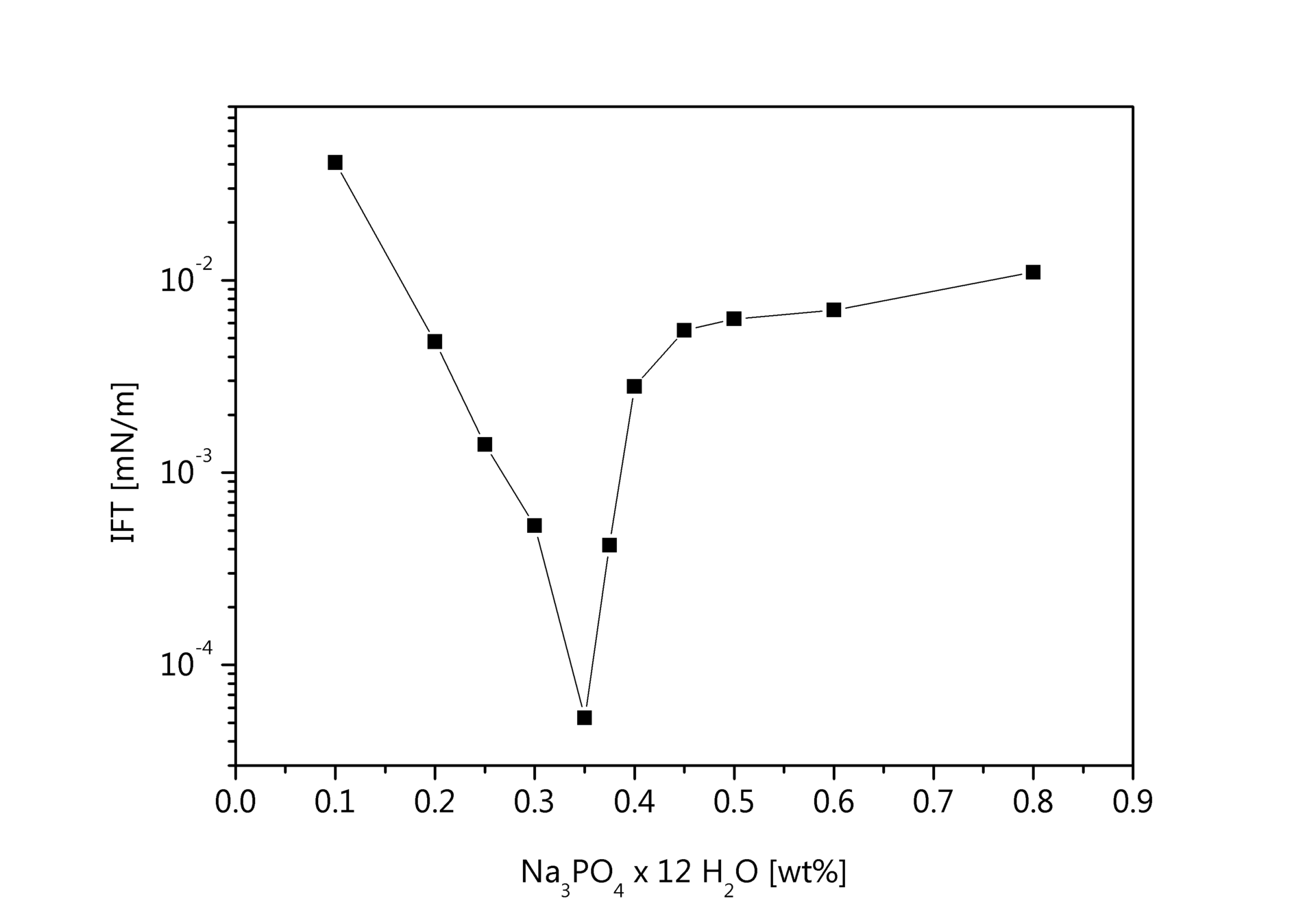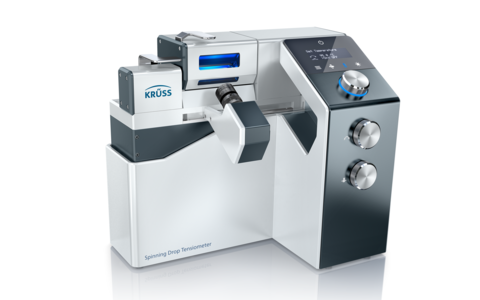
Ultralow interfacial tension in enhanced oil recovery (EOR)
Investigation of a biosurfactant for the environmentally friendly increase of the extraction yield
Increasing energy demands require improved methods for enhanced oil recovery (EOR). Chemical EOR methods are most promising for maximum oil recovery, but, so far, limited due to high costs of chemicals and environmental concerns. Therefore, there is a huge interest in optimizing procedures for chemical EOR that minimize the amount of chemicals needed and rely on natural compounds, thus decreasing costs and environmental stress.
In this application report we review how spinning drop tensiometry can be used to optimize liquid compositions for improved oil recovery yields. Interfacial tension (IFT) between crude oil and aqueous solution of varying composition down to 5·10-5 mN/m were reliably measured with a Spinning Drop Tensiometer ‐ SITE100. At such low IFT values, microemulsions are formed that dramatically increase residual oil recovery.
Background
In oil recovery, conventional methods include the use of the reservoir’s natural pressure (primary phase) and the injection of water or gas (secondary phase) to push out the crude oil to the surface. However, it is well known that reservoirs on average still contain about two-thirds of the original oil-in-place (OOIP) after conventional methods have been applied and thus approximately 2·1012 barrels of oil remain unrecovered.[1] To gain access to this residual oil-in-place, much effort has been spent on developing tertiary phase techniques, so-called enhanced oil recovery (EOR) methods. These methods make use of heat or floods of well-defined composition to mobilize residual oil.
EOR methods A broad range of EOR methods have been introduced, several of which being tested in field projects. An overview of EOR methods can be found in a review by S.Thomas.[1] So far, due to high costs and environmentalconcerns, EOR only constitutes a small percentage oftotal oil production. However, improved technology andrising oil prices driven by tight supply and high energydemand are expected to increase tertiary oil production.
Chemical EOR Of all reported methods, chemical EOR (flooding with water containing chemical additives) is often declared to be the most promising one for maximum recovery of the 2·1012 barrels of oil left underground.[1] Chemical floods containing agents that increase oil mobilization are injected into reservoirs and push out residual oil which otherwise could not be recovered using primary or secondary phase techniques. These floods may contain surfactant (S), alkali (A), polymer (P) or combinations of them (AP-, SP-, ASP-flooding), as well as other (surface-active) auxiliary substances like alcohols.
Polymers, such as partially hydrolyzed polyacrylamide (HPAM) increase the viscosity of the injected fluid and stop it from bypassing areas of recoverable oil, a process called “viscous fingering”.
Surfactants effectively decrease the IFT between crude oil and flooding fluid to values below 10-3 mN/m, which is often required for efficient oil recovery Decreasing the IFT is an appropriate way to raise the capillary number NC and thereby decrease the residual oil saturation, as will be discussed in more detail.
Alkalis also affect the IFT by forming surfactants in situ. Crude oils contain acidic components such as naphtenic acid that, after deprotonation by treatment with alkali (e. g. sodium hydroxide, sodium carbonate or sodium orthosilicate), act as surfactants themselves and lower the IFT. Alkaline flooding is also known as caustic flooding.
IFT and capillary number NC One important parameter EOR methods aim at is the capillary number (NC):

NC expresses the ratio of viscous forces to capillary (interfacial) forces with 𝜈 being the interstitial velocity [m/s] and 𝜇 being the viscosity [Pa·s] of the displacing fluid and 𝛾 the IFT between crude oil and displacing fluid [mN/m = dynes/cm]. High values for NC correlate with decreasing residual oil saturations (Fig. 1).

For a mature waterflooding process, NC is in the range of 10-7 to 10-6, while for fully miscible systems NC approaches infinite values as IFT converges to 0 mN/m. In EOR, NC is manipulated in terms of temperature and mostly by the composition of flooding liquids. Both parameters can help to decrease the IFT between residual oil and inject-ted fluid, thus shift the capillary number to higher values, which positively affect oil mobilization.
The influence of reservoir conditions The idea of enhancing oil mobilization due to a low IFT between oil and displacing fluid by chemical flooding shows promising results in lab and yet, only in China a remarkable amount of oil is recovered by chemical means. To figure out why this is the case and what particular problems may occur in field projects, interactions and conditions in oil reservoirs have to be considered.
Crude oils worldwide differ in chemical composition and physical properties. Depending on the distribution of acidic compounds within crude oil, in situ generation of surfactants by alkaline treatment can have varying impact on the recovery rates. Also, in situ surfactants may exhibit synergistic effects if combined with other surfactants, as described more detailed in another application report.[2] Reservoirs display individual temperature profiles, which have to be taken into account for chemical EOR, as those profiles strongly influence IFT values. Chemical compounds (polymers, surfactants) adsorb to the reservoir walls, the degree of adsorption being determined by the individual reservoir materials (rock, clay). Salinity of the brine that can be used for flooding also strongly influences chemical EOR in terms of IFT values. In conclusion, individual properties of each reservoir and of the corresponding residual oil need to be taken into account, if chemical EOR is to be applied.
Optimization of chemical EOR A major disadvantage of chemical methods compared to other EOR methods lies in the the rather high costs of chemical compounds. Therefore, much effort is put into research on cheap and natural surfactants.
In this application report, the question will be addressed, how costs and environmental damage for the process of chemical EOR can be reduced to a minimum level. For this we illuminate and discuss results recently published by Zhang et al.[3] In particular, the interfacial tension of crude oil against an aqueous solution of modified natural surfactant was measured with a SITE100 spinning drop tensiometer. The influence of chemical modification of the surfactant, of surfactant concentrations, different types of alkali, alkaline concentration and different alcohols were investigated. The SITE100 allows the determination of ultralow IFT values down to 10-6 mN/m, which is sufficiently low for the spontaneous formation of stable oil-water microemulsions. Under these conditions, large amounts of oil can be dissolved in the injected fluid while these microemulsions show advantageous capillary flow properties, overall drastically yielding enhanced oil recovery rates.
Experimental part
Humic acids (humates) are widespread natural organic products of chemical and biological degradation of animal and plant residues. To apply them in EOR means to maximize the utility of natural resources with lowest effects on the environment.
Humic acids were modified by chemical means to increase their interfacial activity. The activity of chemically modified humic acids was checked by measuring the IFT of aqueous solutions of surfactant against crude oil.
Synergistic effects of additional compounds like alkali and alcohol in further decreasing the IFT were investigated. Spinning drop tensiometry was used to optimize the composition of the surfactant solution in terms of producing ultralow IFT values.
A more detailed description of the experimental methods and related results can be found in the original publication by Zhang et al.[3]
Surfactant
Humic acids were extracted from lignite samples (from Wucaiwan Coalmine, China) by alkaline treatment and further purified. These purified humic acids were hydrophobically modified according to Fig. 2.

Oil
Crude oil with an acid number of 1.05 mg KOH per g crude oil and a density of 0.91 g/mL was supplied by Dagang oil fields, China.
Instrument and method
Interfacial tension between crude oil and surfactant solution was measured with a SITE100 spinning drop tensiometer.
Spinning drop tensiometry provides a reliable, yet feasible way to access very low IFT values down to 10‑6 mN/m. A schematic setup of a capillary used for spinning drop tensiometry is depicted in Fig. 3.

The heavy phase (surfactant/brine solution) is filled inside a horizontally arranged glass capillary and a single droplet of the light phase (crude oil) is introduced. The capillary is set in rotation and the drop is elongated by centrifugal force. The IFT tends to minimize the overall surface area of the drop, while centrifugal force favors its elongation. Under equilibrium conditions the diameter of the elongated drop can be measured by automatic pixel analysis of the corresponding camera image and be used to calculate the IFT according to Eq. 2:

with γ being the IFT, d the drop diameter, ω the angular frequency of rotation and Δρ the density difference between light phase and heavy phase.[4]
In order to simulate reservoir conditions, the measuring temperature was adjusted to 45 °C, which is easily done with the SITE100, since the capillary is surrounded by oil at the desired temperature.
Test procedure and results
Humic acid was hydrophobically modified by introducing C10 moieties, forming C10-HANa. The IFT of solutions with varying concentrations of C10-HANa against crude oil is depicted in Fig. 4.

The IFT strongly decreases upon addition of C10-HANa in concentrations up to 0.20 %, while it only slightly decreases as concentration exceeds 0.20 %. This proves that the modified humic acids are capable of lowering the IFT between crude oil and aqueous solution. However, with values larger than 0.1 mN/m, the IFT is far from being sufficiently low to form microemulsions and eventually enhance residual oil recovery.
To further improve the benefit of the modified natural surfactant in terms of decreasing the IFT to ultralow values smaller than 10‑3 mN/m, additionally different kinds of alkali were investigated (Tab. 1). Sodium phosphate gave the best results in lowering the IFT. As explained earlier, alkalis cause in situ formation of surfactants by deprotonation of certain components of crude oil. Synergism of in situ surfactants and modified humic acid drastically decreases IFT values compared to plain surfactant solution.
| Compositional formulation | IFT /10-3 mN/m |
| NaOH (0.1 %), C10-HANa (0.12 %) | 6.78 |
| Na2CO3 (0.2 %), C10-HANa (0.08 %) | 9.70 |
| KOH (0.1 %), C10-HANa (0.08 %) | 4.53 |
| Na3PO4·12H2O (0.15 %), C10-HANa (0.12 %) | 0.48 |
Tab. 1: Test of different alkali components for optimal IFT decrease.[3] Data taken with a KRÜSS SITE100.
In situ formation of surfactants due to deprotonation occurs for all tested alkalis, yet they display different IFT values, ranging from 1·10‑2 to 5·10‑4 mN/m. This can be explained by individual interactions of alkali anions with surfactant molecules at the oil-water interface. For more details we refer to Ref. [2].

The IFT is determined by the alignment and distribution of surfactant, electrolyte and other active compounds at the oil-water interface. Many alcohols show surfactant functionality themselves and can help to optimize the distribution of surfactants at the interface in terms of minimizing the IFT. Four common alcohols (ethanol, n-propanol, iso-propanol and n-butanol) were tested on their ability to further decrease IFT values for improved oil recovery. Among all alcohols investigated, n-propanol clearly resulted in the lowest IFT of all values measured by Zhang et al. (see Fig. 5, 5.3·10‑5 mN/m) at concentrations of 4 %. Values this low are expected to highly increase oil recovery efficiency in chemical EOR processes. Compared to a system of pure water and crude oil, where the IFT typically varies from 20 to 40 mN/m, this is a 105‑ to 106‑fold decrease. According to Eq. 1 and without considering viscous forces to be affected, this results in a 105‑fold increase in NC, thus drastically improving oil recovery. Since these low IFT values were achieved by using natural surfactants and low-cost additional compounds, the process of chemical EOR can be optimized.
Summary
Chemical EOR is expected to be the most effective method for maximum recovery of residual oil in place. As reservoir conditions and crude oil compositions vary worldwide, customized surfactant solutions have to be designed. The Spinning Drop Tensiometer - SITE100 supports rapid screening of optimal chemical composition of floods to achieve ultralow IFT between floods and crude oil. IFT of 5·10‑5 mN/m can be reached and reliably measured. This helps to induce and control the formation of oil-water-surfactant microemulsions, thereby drastically increasing oil recovery efficiency.
Bibliography
- [1] S. Thomas, Enhanced Oil Recovery – An Overview, Oil Gas Sci Technol 2008, 63, 9-19.
- [2] C. Rulison, Synergistic Aspects Of Surfactant Mixtures, KRÜSS Application Report AR 204 1996.
- [3] J. Zhang, G. Li, F. Yang, N. Xu, H. Fan, T. Yuan, L. Chen, Hydrophobically modified sodium humate surfactant: Ultra-low interfacial tension at the oil/water interface, Appl Surf Sci 2012, 259, 774-779.
- [4] B. Vonnegut, Rotating Bubble Method for the Determination of Surface and Interfacial Tensions, Rev Sci Instrum 1942, 13, 6-9.
